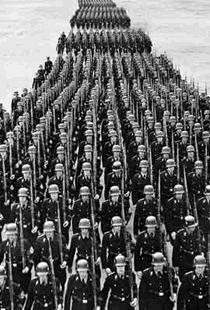1938 - March the 28th 1938 - Sudetenland crisis
begins
April the 24th - SdP issued the Carlsbad Decrees
April the 26th - Czechoslovak government accepted Henlein’s
Home Rule demands
May the 20th - Czechoslovak government in response to rumors of
German troop movements had ordered its troops to the German
border.
August - Chamberlain sends in lord Runciman to negotiate a
settlement between the SdP and the Czechoslovak government
(failed)
September the 29th/30th – Chamberlain appeases, Munich
Agreement signed
Czechoslovakia had a modern army, border fortifications and
alliances and agreements which could have countered Hitler,
would have Chamberlain not appeased again. But as a result of
the agreement, Czechoslovakia had lost its border
fortifications, 70% of its iron/steel production, 70% of its
electrical power, 3.5 million inhabitants, and the Škoda
armament Works to Germany. On October the 5th, Benes resigned.
The initial occupation of Czechoslovak territory commenced on
the day the agreement was signed. |
 |
|
The First Vienna Award
Czechoslovakia began crumbling to pieces soon after. The First
Vienna Award was a result of the Munich Agreement, which in
early November of 1938 forced Czechoslovakia to cede a third of
the Slovak territory (entire southern part) to Hungary. Germany
and Italy were behind the pressure made on Czechoslovakia, and
as a result of the award, Poland occupied some little territory
after as well. It is interesting to note, that soon after the
Munich Agreement 115,000 Czechs and 30,000 Germans fled to the
remaining rump of Czechoslovakia.
On 5th October 1938, autonomous Slovak government led by a
Christian priest Jozef Tiso was formed. On 8th October,
Subcarpathian Ruthenia declared an autonomous government. The
pro-Ukrainian faction, led by Avhustyn Voloshyn, gained control
of the local government and Subcarpathian Ruthenia was renamed
Carpatho-Ukraine. In November, Emil Hácha succeeded Beneš, and
became the president of the federated Second Republic, renamed
Czecho-Slovakia and consisting of three parts: Bohemia and
Moravia, Slovakia, and Carpatho-Ukraine. Without its natural
frontier and having lost its costly system of border
fortification, the new state was militarily defenseless, though
it began building new forts along its new border. In January
1939, negotiations between Germany and Poland broke down.
Hitler, wanting war with Poland, needed to eliminate
Czechoslovakia first. German invasion of Bohemia and Moravia
began on the morning of March 15. Hitler also negotiated with
the Slovak People's Party and with Hungary to prepare the
dismemberment of the republic before the invasion. On March 13,
he invited Jozef Tiso to Berlin and on March 14, the Slovak Diet
convened and unanimously declared Slovak independence. Carpatho-Ukraine
also declared independence but Hungarian troops occupied it on
March 15 and eastern Slovakia on March 23. Hitler summoned
President Hácha to Berlin and during the early hours of March
15, informed him of the German invasion. Under the threat of a
Luftwaffe attack on Prague, Hitler persuaded Hácha to order the
capitulation of the Czechoslovak army. On the morning of March
15, German troops entered Bohemia and Moravia, meeting no
resistance. The Hungarian invasion of Carpatho-Ukraine
encountered some resistance, but the Hungarian army quickly
crushed it. On March 16, Hitler went to Czechoslovakia and from
Prague Castle proclaimed Bohemia and Moravia a German
protectorate. Although the Czechoslovak army, supported by some
new forts along the new border, was ready to fight, for the
second time in its history, weakened by foreign aggression and
internal tensions, Czechoslovakia gave up peacefully.
Consequences
When Mussolini saw how easily and without any resistance Hitler
gained more territory, he decided to invade Albania. Also,
Britain and France gave Poland guarantees of aid in case of
invasion, and expanded their influence even further, making
treaties with Greece and Romania.
http://www.bbc.co.uk/schools/gcsebitesize/...ading_czech.jpg
http://static.howstuffworks.com/gif/axis-c...lippines-39.jpg
http://www.waidev2.com/php/IMAGES/HC_ThisDayInHistory/_2.jpg
|